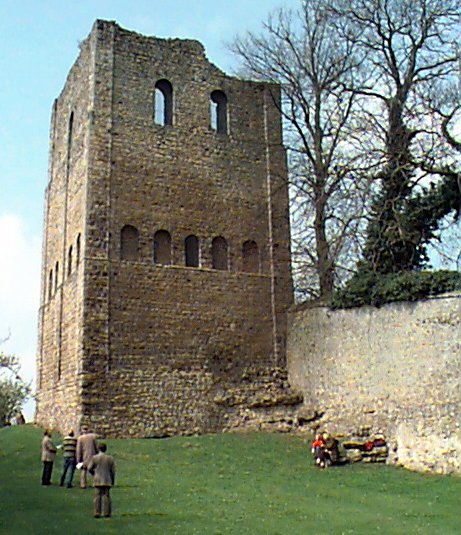St Leonard's Tower
West Malling
 The tower at West Malling is a complex and little understood
structure attributed to the building work of Bishop Gundulf of Rochester
(1077-1108). This attribution is based solely on the tired
old ground of he was a well-known person who built lots of things and
therefore he must have built this. Not surprisingly, we find
in Wikipedia the bold and unreferenced statement:
The tower at West Malling is a complex and little understood
structure attributed to the building work of Bishop Gundulf of Rochester
(1077-1108). This attribution is based solely on the tired
old ground of he was a well-known person who built lots of things and
therefore he must have built this. Not surprisingly, we find
in Wikipedia the bold and unreferenced statement:
West
Malling contains several historic buildings, including St Leonard's
Tower, a Norman keep built by Bishop Gundulf c.1080. He also
built the White Tower of London, the castles of Rochester and Colchester,
and the Priory and Cathedral
of Rochester. In c.1090 Gundulf founded St. Mary's
Abbey in West Malling for Benedictine nuns.
Presumably Gundulf had a little help from masons and the like, but who
knows in Wikiworld? The claims put forward for Bishop
Gundulf's amazing fortification of Kent are way beyond the scope of
such a small article as this, but some comments should be made.
West Malling was given to the bishops of Rochester in the time of King
Edmund (942-46). This shows that an estate existed here by
that date. We also know from a list of c.1120 that both West
Malling (Meallingetes)
and the associated St Leonard (Sanctus
Leonardus) were functional churches and had been so since
Saxon days. No source before the 1860s names Gundulf as the
builder of the ‘castle' at West Malling and these tertiary
sources all freely admit that this is just their best guess.
In short, there is no evidence that Gundulf did anything at West
Malling other than inherit it with the bishopric of Rochester and found
a nunnery there of which there are substantial remains less than half a
mile to the north-east of St Leonard's Tower.
To sum up, the modern attribution of St Leonard's tower
being a castle rather than part of the known church of St Leonard has
no basis other than hearsay. Indeed, even the lack of
defensive
features in the tower structure has never been denied. There
are no traces of ditches or banks or other earthworks that would be
suitable for a castle around the tower, although the walls running off
north and east do have herringbone masonry within them and some small
parts of them could be near contemporary with the tower they butt
against. Further, the eastwards running wall from the tower
contains some remnants of the original St Leonard's church in its
makeup. Again there is no evidence that these walls were
defensive.
The current remains of St Leonard's tower are 32' square, while the
tower itself rises 61' over its plinth. In places this plinth
is up to ten feet high. This design is remarkably similar to Goodrich keep at 29'
square by some 55' high, standing on, in places, a six feet high
plinth. At Goodrich this rough plinth has been stated to have
been covered by an earthen mound, or low motte. No such claim
has been made of the more impressive, but similar plinth at St
Leonards. The difference between the two towers really comes
in height and the blind arcades. Goodrich keep stands
practically to its full height of 55' plus its plinth, while St
Leonard's has lost a complete storey which means that it once stood
over 75' above its plinth. The extra storey was apparently
removed in the Civil War. That apart, the two towers are
quite similar, both having a narrow stair in a corner buttress and
neither having latrines or fireplaces.
The conclusion of this short study is that St Leonard's tower appears
to have been a constituent part of the church of the same name which
stood in close proximity to the tower before its demolition around
1788. This church building is supposed to have been 70' long
by 32' wide. Consequently this can be seen to have been a
substantial building, although it appears never to have been connected
with the tower. Detached towers are well known in many
British churches - Bosbury and Ledbury to name but two from
Herefordshire. By 1154 at the very latest (the time when
William Ypres left England), West Malling nunnery had subsumed St
Leonards, a grant of a five day fair by William Ypres being granted to
God, St Mary, St Leonard and the nuns serving God there.
Subsequent charters show that the church continued in the hands of the
nuns until the dissolution. Although such a history does not
prove that the tower was always part of a church and never a castle,
the implication that such an unfortified tower was never a castle is
clear.
This article is taken from: Goodrich Castle and the families of Godric Mapson, Monmouth, Clare, Marshall, Montchesney, Valence, Despenser and Talbot (ISBN 1-899376-82-8)
Copyright©2019
Paul Martin Remfry
 The tower at West Malling is a complex and little understood
structure attributed to the building work of Bishop Gundulf of Rochester
(1077-1108). This attribution is based solely on the tired
old ground of he was a well-known person who built lots of things and
therefore he must have built this. Not surprisingly, we find
in Wikipedia the bold and unreferenced statement:
The tower at West Malling is a complex and little understood
structure attributed to the building work of Bishop Gundulf of Rochester
(1077-1108). This attribution is based solely on the tired
old ground of he was a well-known person who built lots of things and
therefore he must have built this. Not surprisingly, we find
in Wikipedia the bold and unreferenced statement: